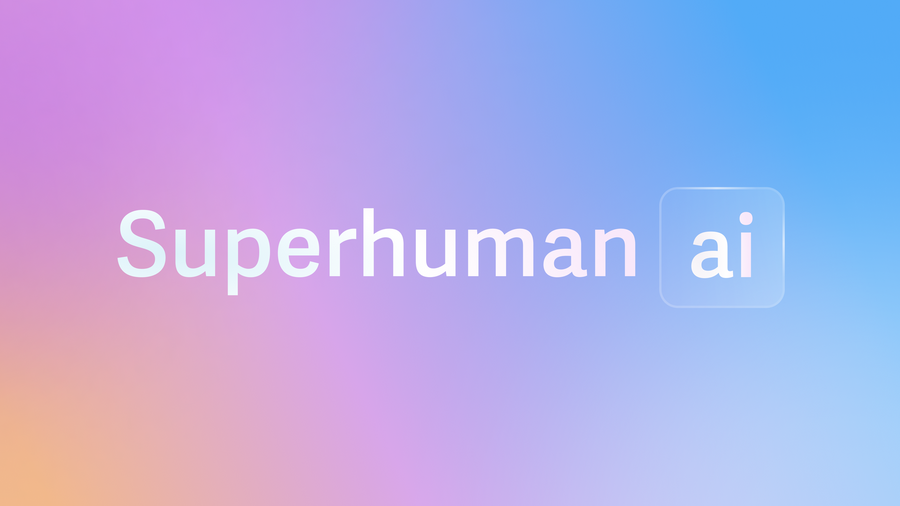
Superhuman is the fastest email experience in the world. Our customers get through their inbox twice as fast as before, reply to their important emails sooner, and save 3 hours or more every single week. This is a story of blood, sweat, and prompts — and how we built Superhuman AI.
It took Instagram two and a half years to reach 100M monthly active users. It took TikTok an impressive nine months. In late November, ChatGPT launched. And just two short months later, ChatGPT reached 100M MAUs, making it the fastest-growing consumer app in history.
By February, it was clear that the way we work was on the cusp of a huge transformation. We saw that large language models could write articles, edit text, research any topic, summarize long documents, and translate between all languages. We naturally wondered whether LLMs could be useful when reading and writing email. If so, we could save customers huge swathes of time, and free them up to be more creative, strategic, and impactful. And of course, it wasn't just us wondering. LLM features rapidly became our top user request, eclipsing the next most requested features by orders of magnitude.
The opportunity was here, and the demand was clear. But how should we get started? None of us were familiar with the technology. And what should we build first? We had so many options to choose from. And how would we even prioritize it? Like every other company, we had way more to build than fit on our roadmap.
How we prioritized AI
We tackled prioritization first. At Superhuman, we have historically used two ways to prioritize features: how valuable the feature is for users, and how valuable the feature is for the business. These measures usually make prioritization easy. But here, they were coming up dry. We couldn't answer how valuable the features would be for users; we didn't know how well they would actually work, nor did we know how they would feel in practice. Similarly, we couldn't answer how valuable the features would be for the business; we didn't know what revenue they could make, nor could we predict what growth they would bring.
Instead, we took a philosophical stance. We stated our core belief: LLMs would change everything. It wouldn't happen overnight, and it may not be obvious how, but they would change the way we work forever. We could either let the market lead and then quickly follow, or we could lead and blaze our own trail.
Which is better? Following quickly, or blazing your own trail?
It may seem counterintuitive, but it is usually better to follow quickly. Apple were not the first to sell retina screens, nor were they the first to build FaceID, but they did those things so well that we call them retina screens and FaceID. And when startups enter new markets, fast followers usually outcompete first movers. Pioneers have arrows in their backs for a reason!
Despite the received wisdom, we decided that we must nevertheless lead. Our customers deserve the fastest email experience in the world, and it is our duty to push that envelope. We had to figure out how to build AI alongside everything else.
In early February, I had hired our first President, Paul Teyssier. Paul is a brilliant leader and operator, and this is exactly the kind of decision that we brought him in to drive.
After some discussions, Paul and I came up with a new mode of operation: theta mode. This was designed to contrast with our standard mode, which we would call alpha mode.
Alpha mode is the default, and almost all projects should use it. In alpha mode, the project team has very high autonomy. The team operates with minimal executive involvement, defines their own goals and metrics, and is accountable for their own progress and outcomes.
Theta mode is the exception, and should be used sparingly. In theta mode, an executive is embedded directly into the project team. The executive takes on individual contributor responsibilities, and provides daily support, guidance, and feedback to ensure that the team succeeds. We expect projects in theta mode to run much faster.
(You might be wondering: why alpha and theta? They are both types of brainwave. Alpha waves are observed when the brain is working coherently. Theta waves are observed when the brain is thinking about the future.)
We created an AI team that ran in theta mode, staffed with one designer, one marketer, and several engineers. I was the embedded executive, and helped with product, design, engineering, and marketing. We worked incredibly hard, pulled out every stop, and operated independently of almost all company processes. In other words, we recreated the first year of Superhuman!
It was chaotic, and at times it was painful, but it worked: in less than 3 months, we went from zero momentum to launching Superhuman AI, and reviews like these:
Testing @Superhuman AI in different languages is absolutely mind-blowing.
— Paco Cantero (@PacocanteroW) July 2, 2023
It seamlessly operates in Spanish and French, delivering results that will leave any business professional astonished!
Thank you for this incredible product! What an investment!
🚀 ✨
I've been blown away by superhuman AI.
— Simon (@seempaq) June 29, 2023
Drafts my responses. Then I tweak & press send.
Email speed just 10x.
WOW WOW WOW 🤩 @Superhuman #AI is like a superpower!!!!! Thank you for the access @rahulvohra @gauravvohra1 🎉⚡️🇺🇸
— TheFlyingVC (@CaptFZ) June 28, 2023
Straight heat from @Superhuman last few weeks. Superhuman AI is exactly what I expected from them. Really well done. Superhuman for Sales I did not see coming, and wow I just enabled and already creating immediate value within the first 60s. 👏 ✨
— Andrew Wyatt (@awhyit) June 28, 2023
How we decided what to build
Once we created the team, we had to decide what to build. There was no shortage of ideas. For example, should we automatically summarize long emails? Or write drafts in advance for you to review? Or let you split your inbox with simple natural language?
These ideas are all great — and we will definitely pursue them — but they are also all preemptive. The user sets up preemptive features once, and they work automatically thereafter.
Not only do preemptive features cost much more to run, they must also meet a higher bar of quality. For example, imagine if automatic summaries or prewritten drafts were low quality. You would tune them out, or just turn them off!
We instead decided to start with features that are on-demand. These are features where the user explicitly asks the AI to do a task. These are tasks like replying to specific emails, summarizing specific conversations, translating drafts, and editing text — all while using the user's own voice and tone.
When building on-demand features, you can worry much less about cost, as cost is always bound by usage. You can also ship while iterating, since results are not automatically shown in the user interface. Best of all, you can combine what you learn about cost with what you learn from iterating, and get ready to build their preemptive counterparts. For example, start with on-demand summaries, and then build preemptive summaries; start with on-demand drafts, and then build preemptive drafts.
How we moved with pace
Once we knew what to build, we had to move fast. We were determined to be first to market, as well as to build the best product.
We moved fast, in large part, due to theta mode. The AI team was smaller than our normal teams, and was separated from almost all company processes. But we also moved fast by setting a very ambitious — and external — deadline.
We know that deadlines are powerful. Dan Ariely found that deadlines help overcome procrastination and improve performance. However, he also found self-imposed deadlines boost performance less than external deadlines.
In most startups, deadlines are internal: we must ship by a somewhat arbitrary date to improve growth, revenue, or product/market fit. As a result, most startups do not benefit from the performance boost of external deadlines. We solved this by using a real external deadline.
I was due to speak at Web Summit Rio, on May 3rd, about how to find product/market fit. The Web Summit conferences are fantastic, and I knew that they attract hundreds of journalists and other members of the media. We told the organizers that we were working on Superhuman AI, and we asked if we could host a press conference about it. They said yes, and we now had our ambitious and external deadline!
How we spread the word
At Superhuman, we produce compelling videos of every feature that we make. This is especially important in a space like ours, where competing products often seem to have similar features. We need to show that our product goes several levels beyond.
We normally produce these videos by first finishing the feature, and then recording it in use. We do this because we will be adjusting the user interface right until launch, and we want the video to be as accurate as possible. However, this process is very time consuming. Between scriptwriting, storyboarding, recording, and editing, it usually adds a week — if not more — to any launch schedule. But our external deadline would not accommodate an extra week!
We decided to do something that we had never done before: decouple the creation of the video from the creation of the feature. The video showcases real results from Superhuman AI, but it is not a recording of the product in action. Instead, it is a recreation in Figma, animated with After Effects. Since we had designed the feature in Figma, storyboarding was fast. And when we inevitably adjusted the user interface, it was relatively quick to adjust the video.
On the day of the press conference, we published the video on Twitter:
NEW: Superhuman AI 🪄
— Superhuman (@Superhuman) May 3, 2023
Write entire messages effortlessly (in your own voice and tone!), translate languages, summarize long emails, and research almost anything — thanks to the power of AI.
Read the news & learn how you can be the first to try it 👇https://t.co/LUEEOfYQXh pic.twitter.com/3vFAlgd6kj
And wow, folks loved the video! The tweet links to a blog post, and the blog post ends with: "Over the next few weeks, we will start rolling out beta access to Superhuman AI. If you’re interested in joining the beta, let us know at hello@superhuman.com." Together, these drove a massive number of signups.
We then started to roll out access in waves: every week we would email a new set of users. Normally, we would include a highly produced marketing video. However, we were still changing the feature frequently. Also, we had to teach people how actually to use the feature. After all, you would not naturally hit Cmd+J to reply to an email.
We again decided to do something that we had never done before: record a 10 minute Loom video that introduces the feature and teaches how to use it. You can see it here:
You can see that the video is very transparent and authentic. It is unscripted, although I knew the main points I wanted to cover. It genuinely shows me driving the feature, even including a momentary blip. And best of all, it visualizes audience reaction via the emoji timeline. Not only does this create social proof, it is significantly more engaging: you are much more likely to watch until the end, if only to see what all the emoji are about.
At the end of the video, I literally ask our users to help spread the word. I think that startups should do this more. Your users want to see you succeed — so feel free to ask for a little help!
With each wave of users, we found new cases that we needed to improve. For example, an early version got a little, well, defensive when asked to write about certain topics:
The above process was a lot of work, but the results were worth it. Superhuman AI outperformed all previous launches, including even Superhuman for Outlook. We can see this not only in the launch metrics, but also in the company metrics that matter most: we have just had four record weeks of growth for Superhuman!
A special Product Hunt deal
We are, of course, just getting started with AI. At present, we are focused on on-demand features. Soon, we will switch to preemptive features. And for after that, stay tuned: we have many exciting AI projects underway, not all of which leverage LLMs.
To celebrate the general availability of Superhuman AI, we are launching a special deal for Product Hunt: two free months on signup! You can get it on the Product Hunt Superhuman product page.
Finally, if there is an AI feature that you would love to see us build, please just let us know at hello@superhuman.com 🙏
Onwards 🚀
Rahul
Rahul Vohra, Founder & CEO of Superhuman


